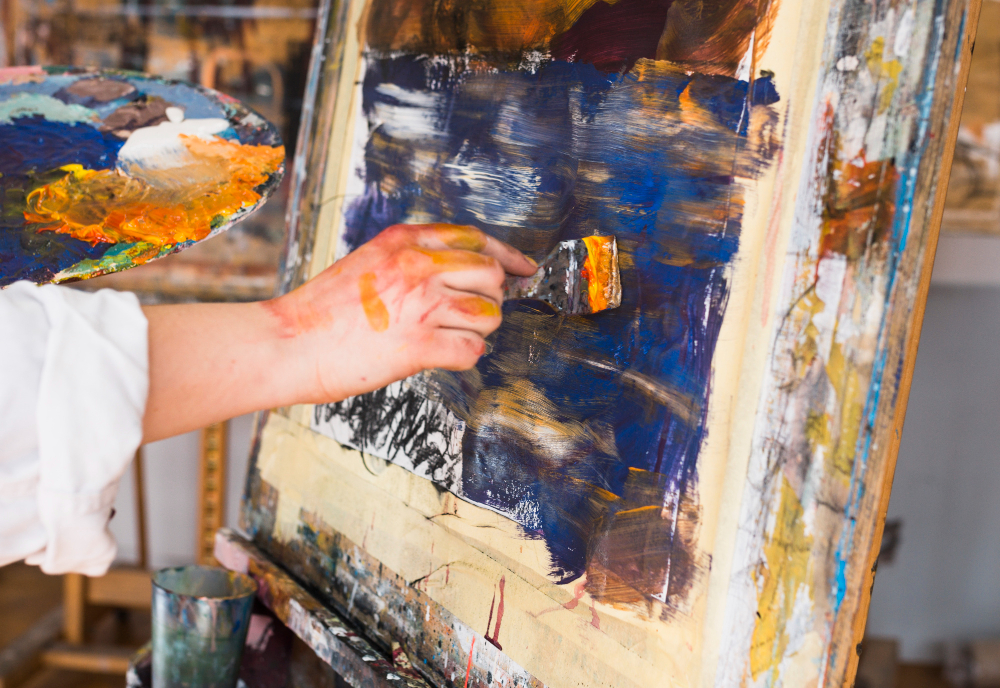The Dutch Golden Age was a remarkable period in art history, characterized by an explosion of creativity and innovation. Dutch painters from the 17th century left an enduring legacy with their exceptional artistry and technical prowess. This article explores ten stunning works of art by Dutch painters that continue to captivate and astonish viewers today.
Dutch Painters’ Masterpiece: The Night Watch by Rembrandt van Rijn
Rembrandt van Rijn’s The Night Watch (1642) is perhaps the most iconic painting of the Dutch Golden Age. This masterpiece is renowned for its dynamic composition and dramatic use of light and shadow. The painting depicts a group of civic guardsmen preparing for a march, but what truly sets it apart is Rembrandt’s ability to capture movement and emotion. The interplay of light enhances the texture of the figures’ clothing and the depth of the scene, making it a profound example of Rembrandt’s genius in blending realism with theatricality.
Dutch Painters: The Enigmatic Beauty of Vermeer’s Girl with a Pearl Earring
Johannes Vermeer’s Girl with a Pearl Earring (1665) is another work by Dutch painters that has captured global fascination. Often referred to as the Mona Lisa of the North, this portrait is celebrated for its exquisite portrayal of light and the mysterious allure of the subject. The painting’s soft, luminous quality and the girl’s captivating gaze create an enigmatic and intimate moment that continues to intrigue and inspire viewers.
The Milkmaid by Johannes Vermeer: A Masterclass in Domestic Realism
Johannes Vermeer’s The Milkmaid (circa 1658) stands out as a stunning example of domestic realism among Dutch painters. This painting depicts a simple kitchen maid pouring milk with meticulous attention to detail. Vermeer’s masterful use of light and color highlights the textures of the milk, the ceramics, and the maid’s attire, transforming an ordinary scene into a work of extraordinary beauty and insight.
Dutch Painters: Frans Hals’ The Laughing Cavalier: A Vibrant Portrait of Character
Frans Hals’ The Laughing Cavalier (1624) is a vibrant and energetic portrait that exemplifies Hals’ exceptional skill in capturing personality and vivacity. The subject’s exuberant expression and elaborate costume are rendered with dynamic brushwork and rich colors. Hals’ ability to convey the sitter’s character through lively detail and spontaneous brushstrokes makes this painting a standout example of Dutch portraiture.
Dutch Painters: The Jewish Bride by Rembrandt: A Deeply Emotional Portrait
Rembrandt’s The Jewish Bride (circa 1665-1669) is a deeply emotional painting that portrays a couple in a tender embrace. This work is celebrated for its intimate portrayal of the subjects and the powerful use of light to accentuate their expressions and garments. The painting’s emotional depth and the meticulous rendering of textures and fabrics highlight Rembrandt’s extraordinary ability to capture human intimacy and affection.
Dutch Painters: View of Haarlem with Bleaching Grounds by Jacob van Ruisdael
Jacob van Ruisdael’s View of Haarlem with Bleaching Grounds (circa 1670) is a stunning landscape painting that showcases the artist’s mastery of atmospheric effects and spatial depth. The painting offers a panoramic view of the Haarlem landscape, with detailed depictions of the city’s bleaching fields and the dramatic sky above. Ruisdael’s ability to capture the grandeur and serenity of the natural world exemplifies his significant contribution to Dutch landscape painting.
Dutch Painters: The Kitchen Maid by Pieter de Hooch: A Tranquil Domestic Scene
Pieter de Hooch’s The Kitchen Maid (circa 1660) is a tranquil depiction of a domestic scene that highlights the artist’s skill in portraying interior spaces and everyday life. The painting features a maid preparing food in a well-lit kitchen, with a focus on the play of light and shadow across the room. De Hooch’s meticulous attention to detail and composition creates a serene and intimate view into 17th-century domestic life.
Dutch Painters: The Windmill at Wijk bij Duurstede by Jacob van Ruisdael
Jacob van Ruisdaels The Windmill at Wijk bij Duurstede (circa 1670) is another masterpiece of Dutch landscape painting. The painting depicts a windmill in the Dutch countryside, with a dramatic sky and lush greenery surrounding the structure. Ruisdael’s skillful rendering of atmospheric effects and his ability to convey the sense of space and light make this work a quintessential example of his landscape artistry.
The Merry Family by Jan Steen: A Lively Genre Scene
Jan Steen’s The Merry Family (circa 1668) is a lively genre scene that captures the chaotic and humorous aspects of domestic life. The painting depicts a family gathering with a mix of laughter and disorder, portrayed with Steen’s characteristic flair for capturing the essence of human nature. The vibrant colors and dynamic composition make this painting a vivid representation of 17th-century Dutch domestic life.
Still Life with a Skull by Pieter Claesz: A Sobering Reflection
Pieter Claesz Still Life with a Skull (1628) is a sobering yet beautiful example of Dutch still life painting. The painting features a collection of objects including a skull, a glass goblet, and various food items, arranged with meticulous attention to detail. Claesz’s use of light and texture, along with the inclusion of the skull as a memento mori, adds a layer of philosophical reflection to the artwork, highlighting the transient nature of life.
Conclusion
Dutch painters from the Golden Age created a legacy of stunning works that continue to leave viewers speechless. Their innovative techniques, masterful use of light, and keen observations of everyday life have ensured their art’s while enduring appeal. The ten masterpieces discussed here showcase the breadth and depth of Dutch art. While each piece reflecting the unique vision and exceptional skill of its creator. Exploring these works offers a deeper appreciation of the artistic achievements of this remarkable period and the lasting impact of Dutch painters while on the history of art.
FAQs
Q1. What made Rembrandt’s The Night Watch stand out in art history?
Rembrandt’s The Night Watch is renowned for its dramatic use of light and shadow, dynamic composition, and ability to capture movement and emotion, while setting it apart as a landmark work in art history.
Q2. Why is Johannes Vermeer’s Girl with a Pearl Earring So iconic?
Vermeer’s Girl with a Pearl Earring is iconic for its captivating portrayal of the subject’s enigmatic expression, masterful use of light, and the painting’s overall sense of intimacy and mystery.
Q3. How did Pieter de Hooch depict domestic life in his paintings?
Pieter de Hooch depicted domestic life with a focus on realistic interior spaces. The play of light and shadow, and serene, intimate moments, while providing a glimpse into 17th-century domestic life.
Q4. What is the significance of Jacob van Ruisdael’s landscapes?
Jacob van Ruisdael’s landscapes are significant for their detailed depiction of natural environments. Along with atmospheric effects, and spatial depth, while highlighting the beauty and grandeur of the Dutch countryside.
Q5. How did Jan Steen’s genre scenes reflect 17th-century Dutch life?
Jan Steen’s genre scenes reflect 17th-century Dutch life through lively. It often humorous depictions of domestic scenes while capturing the essence of daily activities. And social interactions with vibrant color and dynamic composition.
Also read: Den Haag ZH: 10 Exciting Adventures Perfect for Your Weekend





